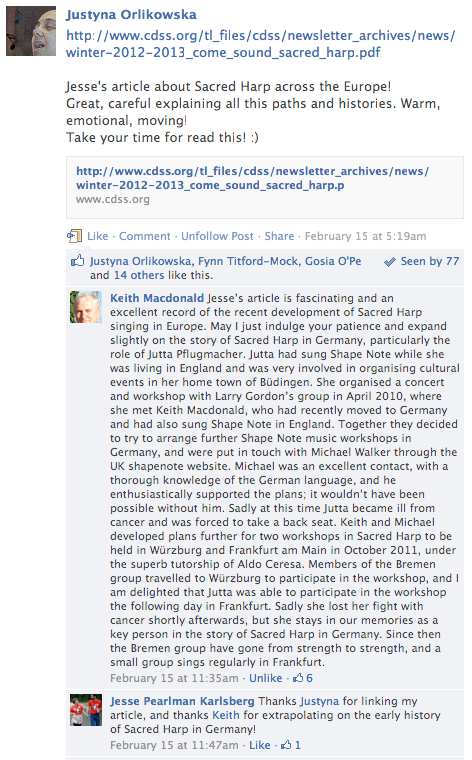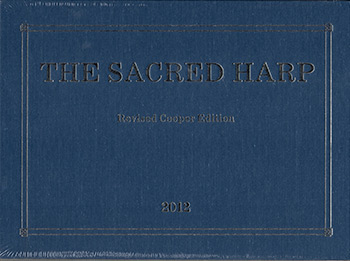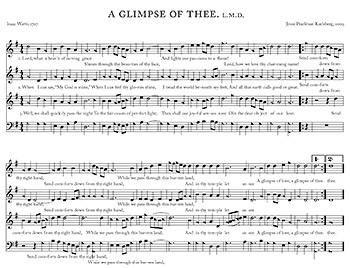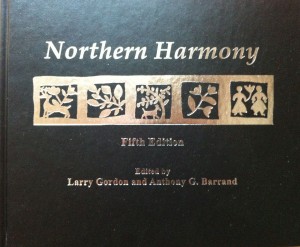A short article of mine on the history of Sarah Lancaster’s song “The Last Words of Copernicus” appears in the Winter 2013 issue of the CDSS News. The essay provides context for the song, touching on the composition of its hymn text by Philip Doddridge, Lancaster’s life as a composer, the addition of an alto part in the early twentieth century, and the song’s subsequent life in the popular imagination thanks to the dissemination of a recording by Alan Lomax later sampled in a hit song by Bruce Springsteen.
Category: Publications
Fourth Issue of the Sacred Harp Publishing Company Newsletter
The recently-published fourth issue of The Sacred Harp Publishing Company Newsletter leads off with Sacred Harp Publishing Company President Mike Hinton’s story about the items tucked into the Bible of his aunt, beloved Sacred Harp singer Ruth Denson Edwards (1893–1978). Buell Cobb shares memories of singings at the Cullman County Courthouse, and an article reprinted from the January 1986 issue of the National Sacred Harp Newsletter features Lonnie Rogers’s and Joyce Walton’s account of a bus trip to the 1985 New England Convention. Another article reprinted from the same issue of the National Newsletter shares Raymond Hamrick’s findings on how singers pitch Sacred Harp music. We have paired it with a new introduction by Ian Quinn, who has recently conducted an extensive study on the same subject. Reports on Sacred Harp singing today in this issue of the Newsletter include Justyna Orlikowska’s account of a month-long trip that took her to the Ireland, Western Massachusetts, and Georgia State Conventions; an essay by Rachel Hall on the making of The Shenandoah Harmony; and an account of the informative and death-defying trip Jason Stanford took to a singing school in South Georgia with Hugh McGraw and Charlene Wallace.
Vol. 2, No. 2 Contents:
- “Aunt Ruth’s Bible,” by Michael Hinton (San Antonio, Texas)
- “The Cullman Courthouse Singings,” by Buell Cobb (Birmingham, Alabama)
- “The Pitcher’s Role in Sacred Harp Music,” by Raymond C. Hamrick (Macon, Georgia), with an introduction by Ian Quinn (Guilford, Connecticut)
- “To Connecticut and Back: Notes from a Bus Trip to the 1985 New England Convention,” by Lonnie Rogers (Ephesus, Georgia) and Joyce Walton (Pisgah, Alabama)
- “The Making of The Shenandoah Harmony,” by Rachel Wells Hall (Philadelphia, Pennsylvania)
- “‘Take My Staff and Travel On’: A Sacred Harp Journey,” by Justyna Orlikowska (Warsaw, Poland)
- “Road Trip to Roberta,” by Jason Stanford (Bremen, Georgia)
- “Congratulations to David Ivey, 2013 National Heritage Fellow,” by Jesse P. Karlsberg (Atlanta, Georgia), and Nathan Rees (Knoxville, Tennessee)
“Douglasville” and “Wilscot” in The Shenandoah Harmony

Two songs of mine, “Douglasville” and “Wilscot,” are included in The Shenandoah Harmony, a four-shape shape-note tunebook published in early 2013.
Edited by a group of eight singers from Boston and the Mid-Atlantic States, this new tunebook was originally imagined by its compilers as “a collection of songs compiled, printed, and published by Ananias Davisson from 1816 to 1826 in the Shenandoah Valley of Virginia,” The music committee ultimately “decided to make a book suitable for all-day singing” and so sought out a larger and broader array of compositions. My two songs are among sixty-eight newly-composed songs in the tunebook. The bulk of the 480-page book features music drawn from shape-note tunebooks published in the Mid-Atlantic states in the first half of the nineteenth century, supplemented by large numbers of earlier New England compositions, and later southern ones. ((Rachel Wells Hall, “The Making of The Shenandoah Harmony,” Sacred Harp Publishing Company Newsletter 2, no. 2 (July 2013), http://originalsacredharp.com/2013/07/29/the-making-of-the-shenandoah-harmony/.))
Though more weighted toward minor music than The Sacred Harp, my two songs in The Shenandoah Harmony are major fuging tunes. I wrote “Douglasville” in March 2008 while on a trip to Georgia with Aldo Ceresa for the Hoboken annual singing and the Georgia State Convention. Inspired by the early-twentieth-century fuging tunes of T. J. and S. M. Denson, and their children Paine, and S. Whitt, the song features an F major key, Common Meter Double text, and limited chordal palette. Though its three separate fuge entrances create some textural interest, the song is among the most conventional I’ve composed. The song was first sung at in April 2008 at the Potomoc River Convention’s “new traditions singing,” where the alto class—a group that included future Shenandoah Harmony music committee member Nora Miller—was particularly enthusiastic about their part.
I wrote “Wilscot” a month later, during the last day of a two-week residency at the Sustainable Arts Society in Blue Ridge, Georgia in April of 2008 and named it for Wilscot, Georgia, a nearby town. I’d continued to experiment writing Denson-style fuging tunes during the stay and this song mixed the idiom with somewhat less conventional chords and ranges. I introduced a larger than usual number of sol-(mi)-sol (V) chords and transplanted the style from its F/Eb major home to A major. I first heard the song at the home of George and Jean Seiler at a social following the June 2008 New York Regional Singing in Albany.
New Issue of the Sacred Harp Publishing Company Newsletter: Volume 2, Number 1
The new third issue of The Sacred Harp Publishing Company Newsletter documents an important chapter in the continuing spread of Sacred Harp singing beyond North America, with singing reports on three Sacred Harp singing events held in Europe last September and on the first Australian All-Day Singing, held last October. Features in this issue of the Newsletter examine how aspects of Sacred Harp music promote the goals of harmony and unity through singing together, tell the story of the Beginner’s Guide to Shape-Note Singing, and relate new findings about Sacred Harp’s early history.
Vol. 2, No. 1 Contents:
- “A Hollow Square in My Homeland: Bringing Camp Fasola to Poland,” by Gosia Perycz (Warsaw, Poland)
- “Celebrating Sacred Harp in Europe, September, 2012,” by Fynn Titford-Mock (Norwich, United Kingdom)
- “Sacred Harp Down-Under: The First Australian All-Day Singing,” by Steven Levine (Minneapolis, Minnesota)
- “My Soul Awoke: The Rocky Mountain Convention,” by Robert McKay (Albuquerque, New Mexico)
- “Harmonious Union: How Sacred Harp Brings People Together,” by Robert T. Kelley (Greenwood, South Carolina)
- “In Search of Silas Mercer Brown,” by Rebecca Over (Ash Vale, United Kingdom)
- “Picturing Song Leaders in Nineteenth-Century America,” by Chris Brown (Elland, United Kingdom)
- “Behind A Beginner’s Guide to Shape-Note Singing,” by Lisa Grayson (Chicago, Illinois)
- “Information on the Lottery for Shares in the Sacred Harp Publishing Company,” by Jesse P. Karlsberg (Atlanta, Georgia)
New Writing on Sacred Harp in Europe
In the wake of my trip last September to attend the seventeenth United Kindom and first Poland Sacred Harp Conventions and to teach at the first European session of Camp Fasola (held the week between these two conventions) I’ve continued to think and write about how Sacred Harp singers conceive of community, tradition, transmission, and place as the style spreads.

In November I wrote for the Country Dance and Song Society News on how these September singings “facilitate[d] cultural exchange, … inspire[d] community, and forge[d] emotional and spiritual connections” among European and North American singers. My essay, “‘Come Sound His Praise Abroad’: Sacred Harp Singing across Europe,” attempts to contextualize these recent events by recounting the introduction of this music to various European countries since 2008. In a comment on Facebook, Keith Maconald helpfully expanded on my account of the early history of Sacred Harp singing in Germany, pointing to the role he and the late Jutta Pflugmacher played in arranging for the Sacred Harp singing schools that Michael Walker and Aldo Ceresa held in Germany in October, 2011 (see screenshot from Facebook at right). I’ve transcribed a portion of Macdonald’s important comment below.
Jutta [Pflugmacher] had sung Shape Note while she was living in England and was very involved in organising cultural events in her home town of Büdingen. She organised a concert and workshop with Larry Gordon’s group in April 2010, where she met Keith Macdonald, who had recently moved to Germany and had also sung Shape Note in England. Together they decided to try to arrange further Shape Note music workshops in Germany, and were put in touch with Michael Walker through the UK shapenote website. Michael was an excellent contact, with a thorough knowledge of the German language, and he enthusiastically supported the plans; it wouldn’t have been possible without him. Sadly at this time Jutta became ill from cancer and was forced to take a back seat. Keith and Michael developed plans further for two workshops in Sacred Harp to be held in Würzburg and Frankfurt am Main in October 2011, under the superb tutorship of Aldo Ceresa. Members of the Bremen group travelled to Würzburg to participate in the workshop, and I am delighted that Jutta was able to participate in the workshop the following day in Frankfurt. Sadly she lost her fight with cancer shortly afterwards, but she stays in our memories as a key person in the story of Sacred Harp in Germany. Since then the Bremen group have gone from strength to strength, and a small group sings regularly in Frankfurt.
Michael Walker also touched on this early history in his essay on the October, 2011 German singing schools for the Sacred Harp Publishing Company Newsletter, “German Singing Schools: Sacred Harp Comes to the Land of J. S. Bach.”
In February I wrote for the Southern Spaces Blog on how the Sacred Harp events in Europe in September, 2012 “served as sites around which singers negotiated their associations of Sacred Harp singing with place.” My blog post—“Sacred Harp, ‘Poland Style’”—described how singers intentionally created what we described as a new “local tradition” of leading P. Dan Brittain’s song “Novakoski” with a time change from slow to moderate-fast at the start of the fuging section. The piece also noted how new singers from Poland and from Norwich in the United Kingdom have appropriated songs in The Sacred Harp bearing the names “Poland” and “Norwich” as symbols of their local Sacred Harp singing communities. My post was published the day before I left Georgia for another European singing trip, this time to Ireland for the third Ireland Sacred Harp Convention. Imagine my delight when the day after I arrived P. Dan told the story of “Novakoski,” “Polish Style” and led the song in the manner described above during his singing school the evening before the convention. Later, during the convention itself, a group of Polish singers led “Poland” and a group of singers from Norwich led “Norwich.” Quod erat demonstrandum.
Earlier in February I spoke about Sacred Harp in Europe at a conference titled “Southern Sounds/Out of Bounds: Music and the Global American South” held at the University of North Carolina, Chapel Hill and organized by the university’s Center for Global Initiatives and Center for the Study of the American South. My paper, “Digital Transmission and Mutable Tradition among European Sacred Harp Singers, 2008–2012,” addressed how European singers have supplemented transmission through travel to singings in the United States with reliance on digital resources such as YouTube videos shared through Facebook, and described how these singers are attempting to strike a balance between adhering to what they see as “traditional” practices while adapting Sacred Harp to new local contexts.
In addition to my two short essays and conference talk, two other short pieces on the Sacred Harp singing events in Europe last fall have recently been published. Gosia Perycz and Fynn Titford-Mock each contributed singing reviews on these three events to the Sacred Harp Publishing Company Newsletter. Their essays: “A Hollow Square in My Homeland: Bringing Camp Fasola to Poland” and “Celebrating Sacred Harp in Europe, September, 2012” describe the U.K. Convention, Camp Fasola Europe, and the Poland Convention in detail and are well worth a read.
Akerman Published in The Trumpet
My tune “Akerman” is included in the latest issue of The Trumpet. I wrote “Akerman” as a present for Laura Akerman in recognition of her thirty-five years at Emory. With help from John Plunkett, Sarah Ward, and Mark Godfrey, I selected a text titled “The books of nature and of scripture,” which we felt might be appropriate for a librarian, and incorporated some musical characteristics of Laura’s favorite compositions.
“A Glimpse of Thee” in The Sacred Harp: Revised Cooper Edition

My song “A Glimpse of Thee” is included in The Sacred Harp: Revised Cooper Edition (Samson, AL: Sacred Harp Book Company, 2012). The song appears on the last page of the book before the index and is re-titled “National Blessings” with an alternate text selected by the book’s revisors.
Colloquially known as the “Cooper book,” this 2012 Sacred Harp edition is the latest in a revision chain stretching back to a 1902 edition of the songbook edited by Wilson Marion Cooper. The first of three competing attempts to refashion the nineteenth century shape-note tunebook for a contemporary audience in the early twentieth century, the “Cooper book” found a following in the area of southeastern Alabama, southwestern Georgia, and north Florida where it was published, as well as in east Texas—it remains the Sacred Harp revision of choice in these areas. ((The songbook was also used alongside other editions of The Sacred Harp in Mississippi, northeast Alabama, and elsewhere.))

More recently, the “Cooper book” has found new audiences across the United States and beyond, often along pathways forged by reciprocal travel between singers from these places in Georgia, Alabama, and Texas, and areas where Sacred Harp singing (primarily from the competing revision chain represented by The Sacred Harp: 1991 Edition) has spread since the 1970s. This new edition alludes to the recent spread of singing from the “Cooper book” through the inclusion of compositions by singers from these new areas and through the titles of some of these singers’ songs, which refer to places (such as “North Jersey”) and people (such as “Gosia [Perycz]”) who are part of this more recent wave of interest in the songbook. ((The 2012 “Cooper book” includes fourteen new tunes, twelve of which are by living composers. These composers hail from Alabama, Florida, Georgia, Minnesota, New York, Oregon, Texas, and Washington.))
I wrote “A Glimpse of Thee” as a setting for Watts’s 1707 hymn “Lord, what a heaven of saving grace …” in August, 2009 while at home in Troy, New York. The “Cooper book” version, “National Blessings,” features the first, second, and fifth stanzas of a hymn written by Alfred A. Woodhull in 1828 which appears in Benjamin Lloyd’s Primitive Hymns ((Wetumpka, AL: published for the proprietor, 1841. Woodhull’s hymn is number 584, the first in the section titled “National Hymns.”)) with the title “God acknowledged in national blessings.”
Copies of The Sacred Harp: Revised Cooper Edition are available from Bill Aplin, Secretary/Treasurer of the Sacred Harp Book Company. Checks, made payable to the book company, may be sent to Aplin at 200 S. Johnson St., Samson, AL 36477. The price for a single book is $25 including shipping. More information is available in chapter one of Steven L. Sabol’s resource guide.
Recent Bulletins on the Southern Spaces Blog
I’ve written two recent posts for the Southern Spaces Blog’s Bulletin compiling news “from in and around the U.S. South.” For the October 18 issue of The Bulletin, I reported on activism surrounding the fortieth anniversary of the 1972 Clean Water Act and decisions by southern states to opt out of Medicaid expansion under the new health care law. In the November 15 issue of The Bulletin, Alan Pike and I surveyed post-election “visualiz[ations of] the geography of political power,” focusing on the historical roots of urban/suburban political divides in metropolitan areas in the interior and rhetoric about the persistance of a “solid South” in presidential politics.
“Clinton,” “Hamrick,” and “Newton” in the Northern Harmony

Three of my shape-note tunes—“Clinton,” “Hamrick,” and “Newton”—are included in the new Northern Harmony (Plainfield, VT: Northern Harmony Publishing Company, 2012). First published in 1980, this fifth edition of the Northern Harmony includes 150 tunes—half written by members of the “first New England School” (1770–1810), and half by contemporary composers working in the dispersed harmony shape-note idiom. Singers across New England use the Northern Harmony as a supplement to The Sacred Harp at weekly and monthly singings. The songbook has also been used by Sacred Harp singers in the United Kingdom since the mid-1990s. A variety of adult and teen performing ensembles brought together by Vermont world music and shape-note music organization Village Harmony also make regular use of the songs in the Northern Harmony tunebook on concert tours and at singing camps.
I attended all-day singings from the Northern Harmony in Vermont and Massachusetts in 2001 and 2002 shortly after I was first exposed to Sacred Harp music. For several years I sang favorite tunes out of the fourth edition of the songbook at “otherbook” shape-note singings at Aldo Ceresa’s apartment in New York City and at various homes in Cambridge, New York. It’s an honor to be included in this new edition, and to have my songs appear alongside those of teachers of mine such as Neely Bruce, and co-conspirators such as Aldo Ceresa and Lauren Bock.
Copies of the Northern Harmony are available online from Village Harmony.
New Issue of the Sacred Harp Publishing Company Newsletter
The new second issue of The Sacred Harp Publishing Company Newsletter features Chloe Webb’s fascinating account of the life of Lorraine Miles McFarland, the girl depicted on the cover of Awake, My Soul as well as a preview of the forthcoming shape note songbook the Shenandoah Harmony. A special section of this issue is a selection of reports on each of the five all-day singings and conventions held on the fifth Sunday this past April (and the Saturday before).
Vol. 1, No. 2 Contents:
- “Sacred Harp’s ‘Yodeling Schoolgirl’: The Story of ‘Little Lorraine’,” by Chloe Webb (Fort Worth, Texas)
- “The Southwest Texas Convention,” by Matt Hinton (Atlanta, Georgia)
- “The 27th Midwest Convention,” by Ted Mercer (Chicago, Illinois)
- “Fish Fry and Fasola: The Harrods Creek/Bob Meek Memorial Convention,” by Michele Cull (Louisville, Kentucky)
- “Fifth Sunday Singing in Old Chicora, Florida,” by Mary Ellen Schrock (Sarasota, Florida)
- “Small in Number Yet Full of Spirit: The Mt. Pisgah Singing in Sylvester, Georgia,” by Trent Peachey (Albany, Georgia)
- “A Preview of The Shenandoah Harmony,” by Rachel Wells Hall (Philadelphia, Pennsylvania)
- “‘Lost Singers’: Help Needed,” by Michael Hinton (San Antonio, Texas)
- Coming soon: “National Newsletter: Vol. 1, Nos. 4, 5, and 6,” digitized copies of issues of the National Sacred Harp Newsletter (September–November, 1985)